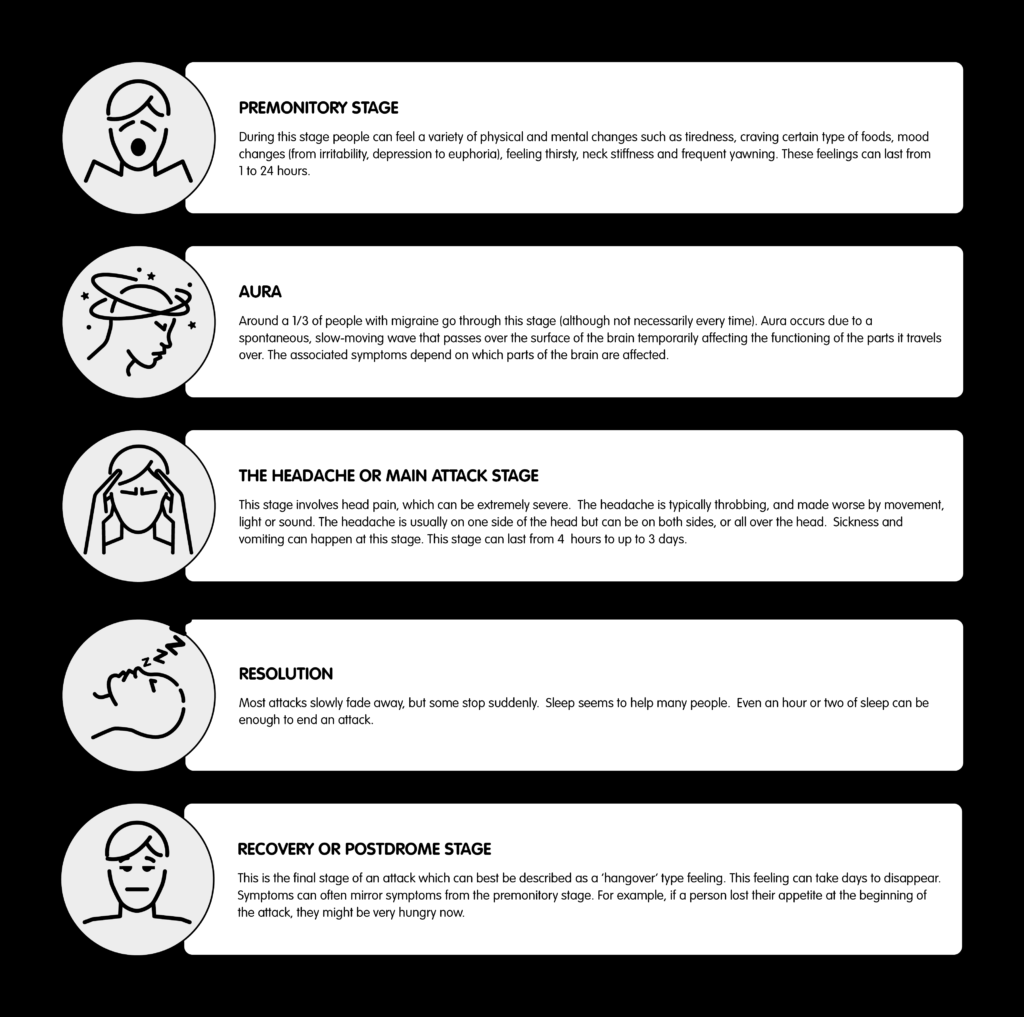Stages of a migraine attack
There are well defined stages of migraine attacks
Migraine is much more than “just a headache”
There are different types of migraine that involve different symptoms. There are many features or symptoms that are a part of migraine. There are also differences in how severe a symptom might be.
The most common symptoms of a migraine attack include:
- throbbing headache
- sensitivity to light, noise and smell
- nausea (feeling sick)
- vomiting (being sick)
- lethargy (lack of energy)
Stages of a migraine attack
It is often difficult to know when a migraine attack is going to happen. However, you can often tell the pattern of each attack as there are well defined stages.
It is these stages and their symptoms that distinguish a migraine from a headache.
However, not everyone will experience all of the symptoms of each stage and the stages can overlap. In adults, we can divide a migraine attack into four or five stages that lead on from each other.

Learning to recognise the different stages of a migraine attack can be useful. You might get one, all, or a combination of these stages, and the combination of stages may vary from attack to attack. Each stage can vary in how long and how bad it is. Recognising different symptoms at different times during your attack can give your doctor information which may help them make a diagnosis. Taking medication as soon as you notice the pain may stop or shorten an attack.
Migraine attacks in children are often much shorter than in an adult. It may be easier to tell the different headache stages in a child.
Premonitory stage
This is sometimes described as the warning stage in which certain physical and mental changes occur. These can include:
- feeling tired
- excessive yawning
- food cravings
- changes in your mood such as feeling down or irritable (high or low)
- Feeling thirsty
- neck stiffness
- passing more urine (wee)
These feelings can last up to 24 hours.
Aura
Around a quarter of people with migraine have aura. Migraine without aura does not include this stage.
The aura of migraine includes a wide range of neurological symptoms. These symptoms include:
- changes in sight (visual disturbances) such as dark spots, coloured spots, sparkles or ‘stars’, and zigzag lines
- numbness or pins and needles
- weakness
- dizziness or vertigo (sensation of spinning and poor balance)
- speech and hearing changes
Some people experience memory changes, feelings of fear and confusion, and more rarely, partial paralysis or fainting.
Aura is the result of a wave of nerve activity that spreads over the brain (known as cortical spreading depression).
As this electrical wave spreads, the nerves fire in an abnormal way and this range of reversible neurological symptoms (aura) develop.
This stage can last from five to 60 minutes, and usually happens before the headache.
In adults, they usually happen before the headache itself, but in children, they may happen at the same time as the headache.
It is possible to have the aura symptoms without the headache, this is often referred to as ‘silent migraine’.
The headache or main attack stage
This stage involves moderate to severe head pain. The headache is typically throbbing and is made worse by movement. It is usually on one side of the head, especially at the start of an attack. However, you can get pain on both sides, or all over the head.
Nausea (sickness) and vomiting (being sick) can happen at this stage, and you may feel sensitive to light, sound, smell and movement. Painkillers work best when taken early in this stage.
Resolution
Most attacks slowly fade away, but some stop suddenly after the person with migraine is sick, or cries a lot. Sleep seems to help many people, even an hour or two can be enough to end an attack. Many children find that sleeping for just a few minutes can stop their attack.
Recovery or Postdrome stage
This is the final stage of an attack, and it can take hours or days for a drained, fatigued or ‘hangover’ type feeling to disappear. Symptoms can be similar to those of the first stage (premonitory). Often, they mirror these symptoms. For example, if you lost your appetite at the beginning of the attack, you might be very hungry now. If you were tired, you might feel full of energy.
Being aware of the different stages of the migraine attack can be helpful. It can help you prepare for an attack, get a diagnosis and decide when to take acute treatment, such as painkillers or adapt your activities.
It is useful to have a rescue treatment plan for when attacks occur. This may include painkillers such as a triptan, a NSAID (e.g. ibuprofen) or paracetamol. It often also includes anti-sickness medication.
For other people, being aware of the stages and symptoms of a migraine attack can help their understanding. It may also help with the frustration and lack of understanding people often face around migraine, especially at work and in education.


